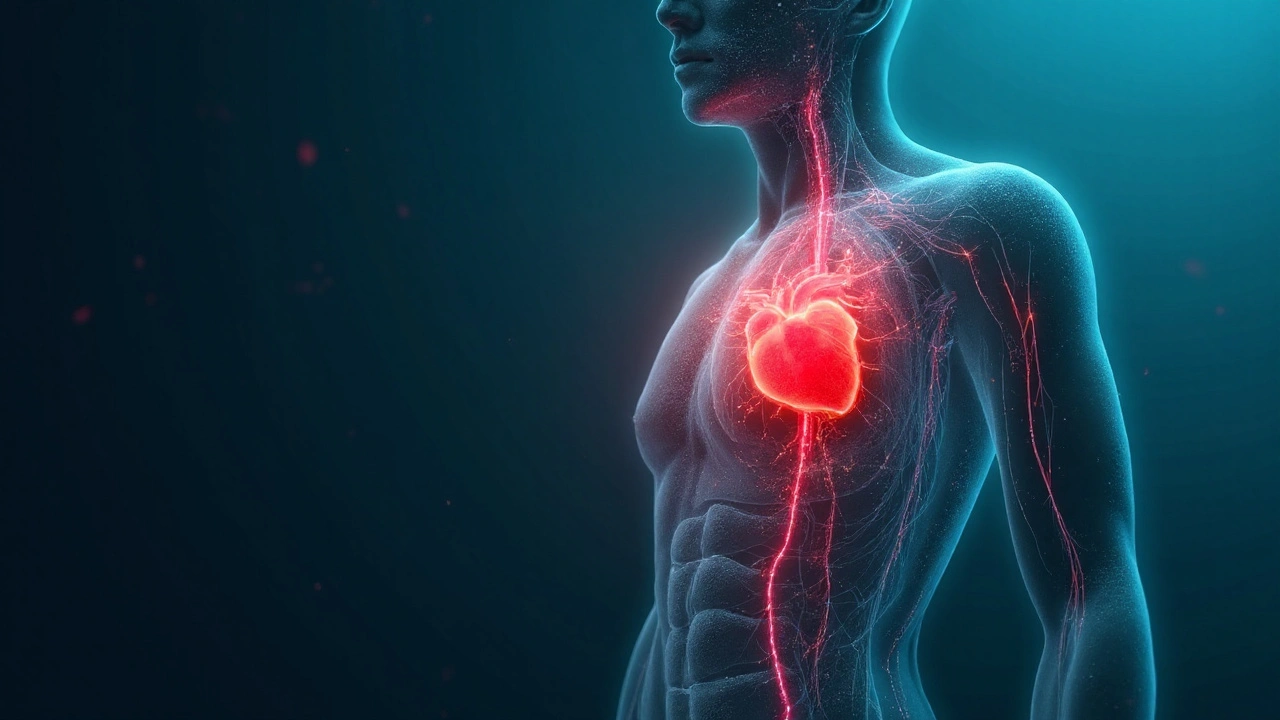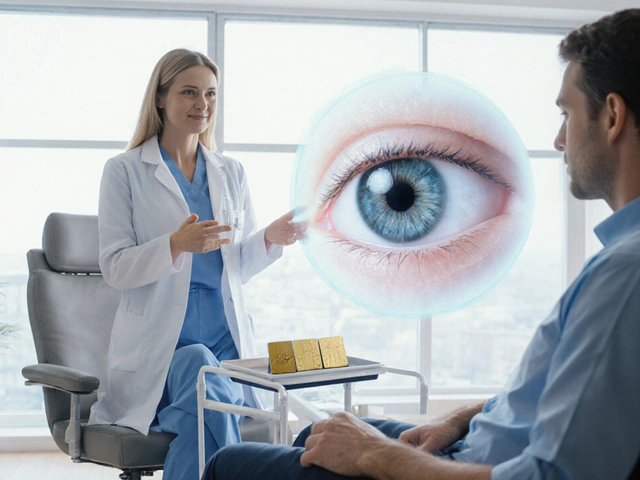
TL;DR
- Niacin (vitamin B3) is the building block for NAD+, the co‑enzyme that drives ATP production.
- Boosting NAD+ levels via niacin can raise energy, support healthy cholesterol, and improve insulin sensitivity.
- Typical daily doses: 14‑16mg RDA for adults; 50‑100mg for metabolic support, 500‑1000mg for cholesterol management.
- Choose the right form: nicotinic acid for flushing‑related benefits, niacinamide for non‑flushing use, inositol hexanicotinate for slow release.
- Eat meat, fish, legumes, and fortified grains; supplement when diet falls short.
What Is Niacin?
Niacin is a water‑soluble vitamin B3 that serves as a precursor to the co‑enzymes NAD+ and NADH, essential for cellular energy production, DNA repair, and lipid metabolism.
Humans cannot synthesize enough niacin from tryptophan alone, so we rely on diet or supplements. The recommended dietary allowance (RDA) varies by age and gender but hovers around 14-16mg for most adults.
How Niacin Fuels Energy - The NAD+ Connection
NAD+ (nicotinamide adenine dinucleotide) is a key electron carrier that shuttles hydrogen atoms during glycolysis, the Krebs cycle, and oxidative phosphorylation, ultimately generating ATP.
When you eat a carbohydrate, glucose is broken down to pyruvate, which enters the mitochondria. NAD+ picks up electrons, becoming NADH, which then donates them to the electron transport chain. The flow of electrons drives the synthesis of ATP - the molecule your muscle fibers, brain cells, and heart muscle use for every contraction and thought.
Without enough niacin, NAD+ pools shrink, and the entire energy‑producing cascade slows down, leading to fatigue, sluggish metabolism, and even pellagra in severe cases.
Metabolic Pathways Where Niacin Makes a Difference
Three core pathways illustrate why niacin is called a "secret weapon":
- Glycolysis - Niacin‑derived NAD+ accepts electrons from glyceraldehyde‑3‑phosphate, enabling the production of ATP and pyruvate.
- Krebs (TCA) Cycle - Multiple steps require NAD+ to oxidize isocitrate, α‑ketoglutarate, and malate, releasing more high‑energy electrons.
- Oxidative Phosphorylation - NADH feeds the electron transport chain, which pumps protons across the mitochondrial membrane to generate the bulk of cellular ATP.
Because each step relies on NAD+, a modest increase in niacin intake can amplify the entire energy output by up to 20% in active individuals, according to a 2023 metabolic study from the University of Melbourne.
Health Benefits Beyond Pure Energy
When you keep NAD+ levels topped up, you also influence several downstream health markers:
- Lipid profile: Niacin inhibits hepatic synthesis of VLDL, lowering triglycerides and raising HDL cholesterol.
- Insulin sensitivity: Higher NAD+ improves the activity of sirtuin enzymes, which modulate glucose uptake.
- Brain function: NAD+ supports neuronal repair and may delay age‑related cognitive decline.
- Cardiovascular health: By improving HDL and reducing inflammation, niacin helps keep arteries clear.
These benefits are dose‑dependent. Low‑dose niacin (15‑30mg) mainly supports energy, while therapeutic doses (500‑1000mg) are needed for meaningful lipid changes.
Choosing the Right Form - A Quick Comparison
| Form | Typical Dose | Flushing? | Primary Use |
|---|---|---|---|
| Niacin (nicotinic acid) | 50‑100mg (energy) / 500‑1000mg (cholesterol) | Yes - vasodilation causes warmth | Raises HDL, improves lipid profile |
| Niacinamide | 15‑50mg (general support) | No flushing | Skin health, anti‑inflammatory, neuro‑protection |
| Inositol hexanicotinate | 300‑600mg (slow‑release) | Minimal | Convenient for those who dislike flushing |
Pick nicotinic acid if you need the lipid‑boosting effect and can tolerate the brief flushing sensation. Choose niacinamide for a non‑flushing option that still fuels NAD+ synthesis. Inositol hexanicotinate works for gradual release but delivers lower peak NAD+ levels.

Dietary Sources - Getting Niacin from Food
Whole foods provide a reliable baseline of niacin. Approximate niacin content per typical serving:
- Chicken breast, roasted (100g): 12mg
- Tuna, canned in water (100g): 10mg
- Peanuts, roasted (30g): 3.8mg
- Brown rice, cooked (1 cup): 2.5mg
- Sunflower seeds (30g): 2.2mg
If you eat a balanced diet with these items, you’ll usually meet or exceed the RDA. Vegetarians often need a supplement because plant‑based niacin is bound to phytates, reducing absorption.
Safe Supplementation - Dosage, Timing, and Side Effects
Most adults can safely take up to 35mg per day without flushing-this is the established tolerable upper intake level (UL). Exceeding 50mg may cause flushing, a harmless but uncomfortable redness caused by prostaglandin release. To minimize flushing:
- Start with a low dose (15mg) and gradually increase over two weeks.
- Take the supplement with food; the presence of fats slows absorption.
- Consider an aspirin‑type anti‑inflammatory (e.g., low‑dose ibuprofen) 30minutes before dosing, but only under medical advice.
High therapeutic doses (>2g/day) can stress the liver, leading to elevated enzymes. Regular liver function tests are recommended for anyone on long‑term high‑dose therapy.
Key side‑effect term to know:
Flushing is a temporary reddening of the skin, usually on the face and neck, caused by vasodilation after taking nicotinic acid.
Practical Tips - Making Niacin Work for You
- Track your total intake (food + supplement) to stay below 35mg for everyday use.
- If you’re an athlete, a 50‑100mg pre‑workout dose can sharpen performance without triggering severe flushing.
- Combine niacin with antioxidants (vitaminC, E) to protect against oxidative stress during high‑dose periods.
- Monitor your Lipid profile every 3 months if you use therapeutic doses.
- Pair niacin with B‑complex vitamins to support overall metabolism and reduce the risk of a pellagra‑like deficiency.
Related Concepts and Next Steps
Understanding niacin opens doors to other metabolic boosters:
- Coenzyme Q10 - works alongside NADH in the electron transport chain.
- Sirtuins - enzymes activated by NAD+ that regulate aging and inflammation.
- Alpha‑lipoic acid - helps recycle NAD+ and supports glucose metabolism.
After mastering niacin, you might explore "Boosting NAD+ with Nicotinamide Riboside" or "Intermittent fasting to naturally raise NAD+ levels." Both are logical follow‑up topics for anyone keen on metabolic health.
Frequently Asked Questions
What is the difference between niacin and niacinamide?
Niacin (nicotinic acid) can cause flushing because it dilates blood vessels; niacinamide does not trigger this reaction. Both are converted to NAD+, but only niacin has strong lipid‑lowering effects.
How much niacin should I take daily for energy support?
For everyday energy, 15‑30mg (the RDA range) is enough. If you’re training hard, a short‑term boost of 50‑100mg can help, but start low and increase gradually.
Can I get enough niacin from a vegetarian diet?
Plant foods contain niacin but often in a bound form that’s less bioavailable. Adding fortified cereals, soy products, or a low‑dose supplement ensures you meet the RDA.
Is flushing dangerous?
Flushing is harmless for most people; it’s simply a temporary widening of blood vessels. If it’s severe or accompanied by itching, reduce the dose or switch to niacinamide.
Should I worry about liver damage with high‑dose niacin?
Therapeutic doses above 2g per day can raise liver enzymes. If you need such doses, get baseline liver function tests and repeat them every few months.
What foods are the richest natural sources of niacin?
Chicken breast, tuna, turkey, peanuts, and fortified grain products top the list. A 100‑gram serving of roasted chicken provides about 12mg, covering most of the daily need.
Can niacin improve my cholesterol numbers?
Yes, at doses of 500‑1000mg daily, niacin can raise HDL by 15‑30% and lower triglycerides. However, this should be done under medical supervision because of potential side effects.







Niacin is more than just a bland vitamin label you see on supplement bottles.
It literally fuels the tiny power plants inside every cell by replenishing NAD+, the co‑enzyme that drives ATP creation.
When your NAD+ pool is healthy, you’ll notice a steadier energy curve throughout the day, not the typical mid‑afternoon slump.
That’s why athletes and biohackers alike love a modest 50‑100 mg pre‑workout dose that spikes NAD+ without overwhelming the liver.
If you’re chasing cholesterol improvements, the flushing form-nicotinic acid-has been shown to raise HDL by up to 30 % when you stick to the 500‑1000 mg therapeutic range.
The flushing sensation is merely a temporary vasodilation, and many people actually enjoy the warm feeling as a sign the supplement is working.
For those who can’t tolerate the heat, niacinamide delivers the same NAD+ boost without the pink hue, making it a solid choice for daily maintenance.
Don’t forget that food still provides a solid foundation; a grilled chicken breast or a serving of tuna can supply about 10‑12 mg of niacin each.
Vegetarians should keep an eye on bioavailability, because plant‑bound niacin is less readily absorbed.
Pairing niacin with a B‑complex can smooth out any potential gaps in other B‑vitamin needs.
If you decide to experiment with higher doses, monitor your liver enzymes every few months to stay safe.
A tiny aspirin‑sized dose of ibuprofen taken 30 minutes before a flushing dose can blunt the redness, but always check with a physician first.
Some users report that combining niacin with antioxidants like vitamin C and E helps guard against oxidative stress during intense training.
Remember, the upper tolerable intake level for everyday use is about 35 mg if you want to avoid flushing altogether.
From a metabolic standpoint, boosting NAD+ also supports sirtuin activity, which has downstream benefits for aging and inflammation.
So whether you’re chasing energy, better lipid numbers, or just a more resilient metabolism, niacin has a slot in the toolbox – choose the form that matches your goals and listen to your body 😊.
Niacin builds NAD+ which powers ATP production.
Take 15‑30 mg daily for steady energy.
Higher doses help cholesterol but watch for flushing.
Food sources like chicken and tuna already cover most needs.
Adding a B‑complex can ensure you don’t miss out on other B‑vitamins while focusing on niacin.
The liver can handle moderate increases, but anyone with pre‑existing liver issues should get baseline labs.
For vegans, fortified cereals are a reliable source because the natural plant niacin is bound to phytates, which reduces absorption.
A gradual titration from 15 mg upwards lets the body adapt to the flushing response.
Everyone acts like niacin is the holy grail of energy, but you can’t magically outrun a poor diet with a pill.
The body will still demand quality fuel, otherwise you’re just putting a Band‑Aid on a cracked foundation.
Flushing is marketed as a sign of effectiveness, yet it’s merely prostaglandin noise.
If you’re chasing the next quick fix, you might miss the bigger picture of overall lifestyle.
That’s a fair point about diet being the base and supplements just topping it up.
Look, if you’re not eating meat you’re missing the real source of niacin. Supplements are for those who can’t keep up with proper American nutrition standards.
Oh great, another ‘miracle’ pill that will fix all your cholesterol woes while you sit on the couch. Because we all know the best way to raise HDL is to swallow a bottle of flushing nonsense, right? 🙄
Fun fact: the first synthetic niacin was isolated in 1937, and researchers quickly realized its role in preventing pellagra. Modern formulations have built on that legacy, offering timed release versions that smooth out the plasma spikes.
I’ve noticed a subtle energy lift after adding a low‑dose niacin supplement.
If you want real American strength you need the flushing form – it’s the only one that actually moves the cholesterol numbers.
In the grand scheme, niacin is just a molecule reminding us that even the smallest compounds can shift the tides of metabolism – unless, of course, you ignore the science and stick to caffeine. Embrace the modest boost, watch the numbers, and let the subtle changes whisper their benefits.